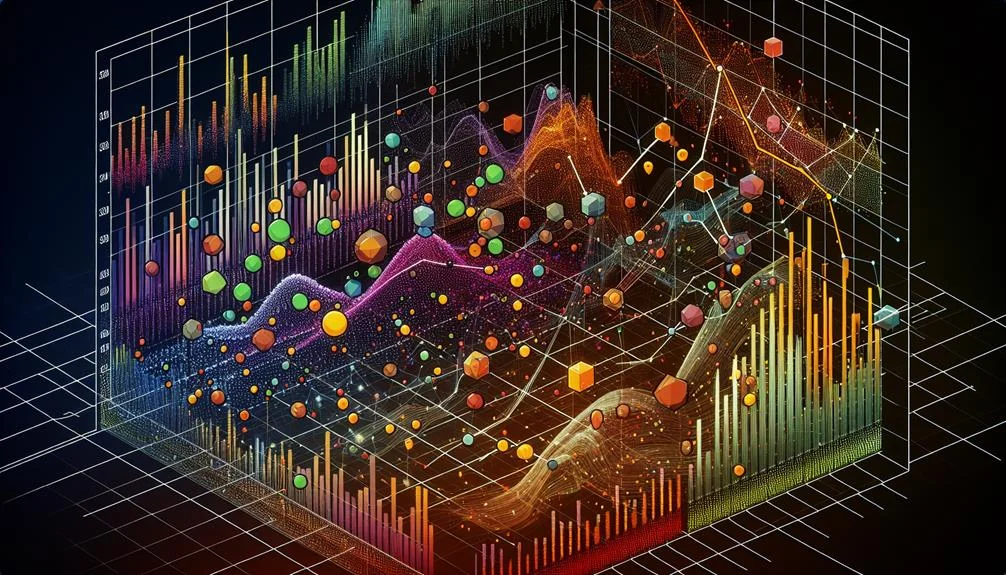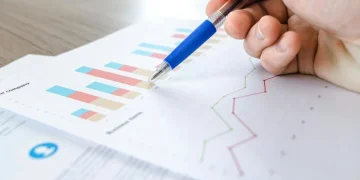Data visualization serves as a key element in data science, transforming complex datasets into comprehensible visual formats that facilitate the identification of patterns, trends, and anomalies. This process not only aids in the extraction of actionable insights but also enhances the communication of findings to stakeholders.
By leveraging various tools and techniques, data scientists can present data in a visually compelling manner, thereby supporting informed decision-making and strategic planning. What specific methods and tools are most effective in achieving these goals, and how are they applied across different industries?
Key Takeaways
- Data visualization simplifies complex data, making it easier to understand.
- It helps identify patterns, trends, and outliers in data sets.
- Facilitates data-driven decision-making through enhanced interpretation of information.
- Improves communication and retention of data insights.
- Supports effective storytelling with data for strategic analysis.
Understanding Data Visualization
Understanding data visualization is essential for translating complex data sets into visual formats that facilitate easier interpretation and analysis. Data visualization in data science involves transforming large, multifaceted data sets into comprehensible visual representations such as charts, graphs, and dashboards.
This process is fundamental for data scientists, enabling them to identify patterns, trends, and outliers that might otherwise remain obscured in raw data.
The importance of visualization in data science cannot be overstated, as it aids in extracting actionable insights from complex data sets. By utilizing different types of data visualization techniques, such as bar charts, line charts, scatter plots, pie charts, and histograms, data scientists can present data in a format that stakeholders can easily understand.
These visual tools not only streamline the analytical process but also support better decision-making by making insights more accessible and interpretable.
Effective data visualization is critical in storytelling with data, offering a visually compelling narrative that highlights key insights. This visual representation is particularly important in data science projects, where making informed decisions based on data-driven insights is paramount.
Through these methods, data visualization bridges the gap between complex data and comprehensible information, thereby enhancing the overall analytical process.
Data Visualization Key Tools and Techniques

Key tools and techniques in data visualization are pivotal for transforming complex data sets into actionable insights, leveraging sophisticated software like Tableau, Jupyter, Plotly, Power BI, and Qlikview. These data visualization tools enable analysts to utilize traditional techniques such as bar charts, line charts, and pie charts, along with more intricate methods like infographics and treemaps, to represent data visually.
Business intelligence reporting tools provided by these platforms can automatically generate detailed dashboards, facilitating a streamlined data analysis process. The interactive capabilities embedded within these tools allow users to explore deeply into data sets, enabling nuanced examination and real-time adjustments. This interactivity is essential for uncovering hidden insights and fostering a more dynamic analysis environment.
Moreover, vendors like Tableau and Microsoft Power BI offer extended functionalities specifically designed for big data environments. These extended functionalities include features such as advanced data connectivity, real-time data processing, and scalable architecture, which are essential for handling large volumes of data efficiently.
The versatility and robustness of these data visualization tools make them indispensable in the toolkit of any data scientist, enhancing their ability to convey complex information clearly and effectively.
Identifying Data Visualization Patterns and Trends

The process of identifying patterns and trends in data science is greatly enhanced through data visualization techniques.
By transforming raw data into visual formats such as heat maps, scatter plots, and line graphs, data scientists can effectively recognize visual patterns and employ trend analysis techniques to extract meaningful insights.
These visual representations facilitate a more intuitive understanding of complex datasets, enabling precise detection of correlations and anomalies.
Recognizing Visual Patterns
Recognizing visual patterns in data visualization enables data scientists to identify trends, outliers, and correlations within complex datasets, facilitating a deeper understanding of the data. By using data visualization, patterns in the data become more apparent, allowing for the extraction of actionable insights.
The ability to discern trends and correlations is crucial in data science, where large datasets often obscure meaningful information. Visual patterns highlight these elements, transforming raw data into clear, interpretable insights.
| Aspect | Description | Benefit |
|---|---|---|
| Trends | Recognizing upward or downward movements in data | Facilitates predictive analytics |
| Outliers | Identifying data points that deviate significantly from other observations | Enhances anomaly detection |
| Correlations | Discovering relationships between different variables | Improves understanding of data dynamics |
| Large Datasets | Handling and analyzing substantial volumes of data | Enables thorough data analysis |
Visual patterns also aid in uncovering hidden insights that may not be immediately evident through traditional data analysis techniques. This capability is essential for data scientists aiming to derive actionable insights from their datasets. By effectively communicating these patterns and trends to stakeholders, data scientists ensure well-informed decision-making.
The intuitive nature of visual patterns helps in simplifying complex data structures, making intricate relationships and distributions more accessible and understandable. Recognizing visual patterns is a cornerstone of effective data science, enhancing both analysis and communication.
Trend Analysis Techniques
How do data scientists leverage trend analysis techniques in data visualization to uncover hidden patterns and predict future outcomes with precision?
Trend analysis techniques are pivotal in data visualization, enabling data scientists to decipher complex datasets by identifying patterns and trends. Utilizing visual tools like line charts and scatter plots, these techniques facilitate the detection of correlations and trends over time, transforming raw data into actionable insights.
The examination of historical data through data visualization allows data scientists to understand past trends, which is essential for accurate forecasting. By recognizing recurring patterns, they can predict future outcomes, enhancing strategic decision-making processes. For instance, observing sales data trends can inform inventory management and marketing strategies, thereby optimizing operational efficiency.
Tools such as Tableau and Plotly are instrumental in this endeavor. Tableau, in particular, offers robust trend analysis features that support the visualization and interpretation of data, making it easier for data scientists to uncover correlations and derive insights. These visualizations not only simplify complex data but also highlight significant trends and patterns that might be overlooked in raw data analysis.
Consequently, trend analysis techniques in data visualization are essential for forecasting and strategic decision-making in data science.
Enhancing Data Visualization

Converting complex datasets into visual formats like charts and graphs greatly enhances data interpretation, enabling data scientists to quickly identify patterns, trends, and outliers for deeper analytical insights.
Data visualization serves as a bridge between raw data and comprehensible insights, transforming voluminous and intricate datasets into intuitive images that allow for immediate recognition of significant data points. These visual formats streamline the analytical process by making it easier to discern correlations and deviations that might be obscured in tabulated data.
By leveraging data visualization, data scientists can:
- Identify patterns and trends: Visual representations, such as line charts and heat maps, make it simpler to observe data behaviors over time or across various dimensions.
- Highlight outliers: Scatter plots and box plots are particularly effective for spotting anomalies that could indicate errors or significant events.
- Communicate findings: Visual formats facilitate clear and concise communication of complex data insights to stakeholders, ensuring that non-technical audiences can grasp key points and implications.
Thus, the role of data visualization in enhancing data interpretation is pivotal. It not only provides deeper insights but also supports the creation of compelling narratives, essential for communicating findings and bolstering effective decision-making in data science.
Facilitating Decision Making With Data Visualization

Data visualization plays a pivotal role in facilitating decision-making by simplifying complex information, enabling swift identification of trends, and enhancing data interpretation.
Simplifying Complex Information
Transforming large datasets into visual formats such as charts and graphs, data visualization simplifies complex information, thereby facilitating more effective decision-making processes. This transformation is essential for presenting trends, patterns, and outliers in a manner that is easily comprehensible.
Through data visualization, data scientists can distill vast arrays of complex information into more digestible visual representations, which aids stakeholders in identifying correlations and making informed decisions based on actionable insights.
Data visualization not only enhances data exploration but also greatly improves understanding. The ability to quickly analyze and interpret complex datasets allows decision-makers to derive insights that are critical for strategic planning and operational efficiency. Visual formats such as bar charts, scatter plots, and heat maps serve as tools that bridge the gap between raw data and strategic decisions.
Key benefits of data visualization in simplifying complex information include:
- Enhanced Clarity: Visual formats make it easier to understand data, highlighting key trends and patterns.
- Efficient Decision-Making: By presenting data in a clear and concise manner, decision-makers can make informed choices swiftly.
- Identification of Outliers: Visual tools help in spotting anomalies that may require further investigation.
Thus, data visualization plays an indispensable role in translating complex datasets into actionable insights, driving effective decision-making.
Identifying Trends Quickly
Visual representations like charts and graphs enable data scientists to swiftly identify trends within complex datasets, thereby facilitating more informed and timely decision-making processes. By translating intricate data into visual formats, data visualization allows for the efficient detection of patterns, outliers, and correlations. This capability is vital for extracting valuable insights that drive strategic business decisions.
Efficiently recognizing key trends in data can greatly impact decision-making. For instance, identifying an upward trend in sales can prompt a business to increase production. Spotting an outlier in customer feedback might highlight an area requiring immediate attention.
The following table illustrates how different visualization types can aid in identifying various data characteristics:
| Visualization Type | Key Feature Identified | Typical Use Case |
|---|---|---|
| Line Chart | Trends | Monitoring sales over time |
| Scatter Plot | Correlations | Analyzing relationship between variables |
| Bar Chart | Patterns | Comparing revenue across regions |
| Box Plot | Outliers | Detecting anomalies in data |
| Heat Map | Insights | Visualizing data density |
Through such visual tools, data scientists can efficiently extract actionable insights, thereby facilitating data-driven decision-making. The ability to identify trends and patterns quickly is essential in the fast-paced environment of modern data science, ensuring that decisions are based on clear and concise visual evidence.
Enhancing Data Interpretation
Effective data interpretation is essential in data science, as it enhances decision-making by transforming complex datasets into clear, actionable visual insights. Data visualization helps to distill vast amounts of complex information into comprehensible visual formats, making it easier for stakeholders to grasp key patterns, trends, and outliers.
By employing visual tools, data scientists can identify correlations and relationships within datasets that might otherwise go unnoticed, thereby enabling informed and strategic decisions.
The utilization of data visualization in science is instrumental in the following ways:
- Simplifying Complexity: Visual representations are used to break down intricate datasets into simpler, more digestible visuals, eliminating the need for extensive analysis.
- Facilitating Communication: Data visualization helps communicate findings effectively to non-technical stakeholders, ensuring that essential insights are understood and acted upon.
- Enhancing Storytelling: Crafting a narrative around the data through visual tools makes the information more engaging and compelling, thereby driving data-driven decision-making processes.
Communicating Insights Effectively With Data Visualization

Communicating insights effectively in data science hinges on the ability to translate complex data sets into clear and compelling visual narratives. Visualizations such as line charts and bar graphs play a pivotal role in data analytics by illustrating trends, patterns, and outliers that might otherwise remain hidden in raw data.
The importance of data visualization lies in its capacity to transform abstract numbers into intuitive visual representations, making it essential in data-driven decision-making processes.
By implementing visualization, data scientists can present findings in a manner that stakeholders can easily grasp, thereby facilitating informed decisions. For instance, line charts are instrumental in depicting temporal trends, while bar graphs excel at comparing categorical data.
These tools are not merely aesthetic enhancements but fundamental instruments in the arsenal of data analytics, aiding in the synthesis and communication of complex insights.
Effective data visualization is essential for constructing a coherent narrative around the data, enabling stakeholders to quickly identify key insights and act accordingly. Essentially, the ability to communicate insights through visual means is indispensable for the data scientist, ensuring that data-driven strategies are both understood and actionable.
Use Cases in Various Fields

Data visualization plays an integral role across various fields by enabling professionals to distill complex datasets into actionable insights, ultimately driving informed decision-making and strategic planning.
In business intelligence, data visualization tools facilitate web traffic analysis and the evaluation of marketing campaigns. This allows companies to track the correlation between marketing efforts and sales, making it easier to adjust strategies in real-time.
In healthcare, visualizations such as choropleth maps are pivotal for identifying areas needing healthcare interventions. By mapping health variables and mortality rates, healthcare providers can better allocate resources and address public health concerns effectively.
Scientific visualization greatly aids researchers by providing deeper insights into experimental data. Visual representations help to uncover new discoveries and foster collaboration among scientists, enhancing the overall research process.
Political data visualization, through the use of geographic maps, is essential for analyzing voting trends and patterns. Such visual tools offer a clearer understanding of the political landscape, informing strategic decisions during elections.
Finance professionals leverage candlestick charts to monitor investment performance and discern market trends swiftly. This visual approach facilitates making informed investment decisions based on concise and accurate financial data.
Conclusion
Data visualization in data science acts as a bridge between complex datasets and comprehensible insights, much like a translator converting intricate languages into clear messages. By employing various tools and techniques, data visualization aids in identifying patterns, enhancing interpretation, facilitating decision-making, and effectively communicating findings.
Its role is indispensable across multiple fields, driving strategic decisions and fostering a deeper understanding of data-driven insights.





